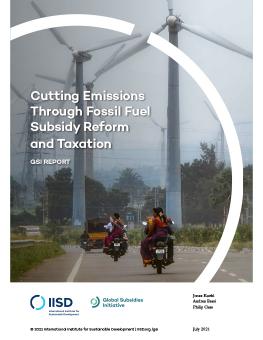
Cutting Emissions Through Fossil Fuel Subsidy Reform and Taxation
This report models the climate change mitigation potential of fossil fuel subsidy reform across 32 countries. The results show how much greenhouse gas emissions—both in per cent as well as in absolute terms—countries can save by 2030. In addition, the model also calculates the subsidy savings countries can gain from fossil fuel subsidy reform. Countries can further increase their emission reductions by adding fossil energy taxation as well as the investments of subsidy savings and tax revenue into energy efficiency and renewable energy to the scenario.
Using the Global Subsidies Initiative – Integrated Fiscal Model (GSI-IF model), this report models the impact of fossil fuel subsidy reform (FFSR) on greenhouse gas (GHG) emission reductions for the following 32 countries: Algeria, Argentina, Australia, Bangladesh, Brazil, Canada, China, Egypt, Ethiopia, Germany, Ghana, India, Indonesia, Iran, Iraq, Japan, Mexico, Morocco, Myanmar, Nigeria, Pakistan, Russia, Saudi Arabia, South Africa, Sri Lanka, Tunisia, United Arab Emirates, the United States, Venezuela, Vietnam, the Netherlands, and Zambia. In total, these 32 countries accounted for 77% of global carbon dioxide emissions, 72% of global GDP, and 72% of the global population in 2019.
The GSI-IF model uses semi-continuous simulations to forecast energy demand and corresponding GHG emissions. It considers the gradual removal of all fossil fuel subsidies to consumers until 2030, a gradual introduction of a 10% fossil energy tax until 2030, and the investment of 30% of both subsidy savings and tax revenues to energy efficiency and renewable energy from 2021, respectively 2026, onwards.
The research finds a simple country average in GHG emission reductions of about 6% by 2030 compared to business as usual, while the data shows that FFSR can reduce as much as 35% of emissions in the countries modelled. Adding emission reductions from the fossil energy tax as well as the investments of parts of the subsidy savings and tax revenues into sustainable energy would almost double the average GHG emission reductions to 11.8% by 2030. Cumulative fiscal savings from FFSR alone by 2030 total close to USD 3 trillion across the countries analyzed, with total cumulative GHG emissions abated from FFSR of 5.4 gigatonnes of carbon dioxide equivalent (GtCO2e) by 2030—equivalent to the annual emissions of about 1,000 coal-fired power plants or 3.8 billion cars. For every tonne of CO2e removed through FFSR alone, governments save about USD 546.47 on average. When considering the resources reallocated via the subsidy swap, governments can increase their emission reductions and still save USD 164 for every tonne of CO2e removed.
You might also be interested in
At long last, Canada restricts oil and gas subsidies (except for all the loopholes)
Environment and Climate Minister Steven Guilbeault has unveiled detailed plans to phase out "inefficient" oil and gas subsidies, based on guidelines released yesterday morning that take effect immediately and are meant to fulfill a 14-year-old pledge by G20 countries.
Heatwaves to hit China once every 5 years as global extreme weather events multiply, study finds
Record-breaking heatwaves that have scorched North America, Europe and China are set to worsen in future unless the world stops burning fossil fuels, according to a study by the World Weather Attribution (WWA) academic initiative.
Canada to Cut Oil & Gas Subsidies
The Canadian federal government has implemented a framework to revoke subsidies for fossil fuels that are deemed inefficient. However, the framework lacks details on the specific subsidies to be eliminated and does not provide a dollar amount for the cuts. Canada, as the fourth-largest oil producer in the world, is the first country to comply with a 2009 pledge made by the Group of Twenty (G20) nations. The government plans to exempt oil and gas projects that have plans to reduce emissions and utilize carbon capture and storage (CCS) technology. Federal Environment Minister Steven Guilbeault stated that the objective is for federal support to be directed only towards projects that decarbonize the sector and result in significant greenhouse gas emissions reductions.
Canada Bans Some Fossil Fuel Subsidies, Meeting Decade-Old G-20 Pledge
Canada revealed new rules to ban some fossil fuel subsidies, targeting those that unfairly advantage oil and gas, solely support sector activities or endorse consumption of fuels that worsen climate change.